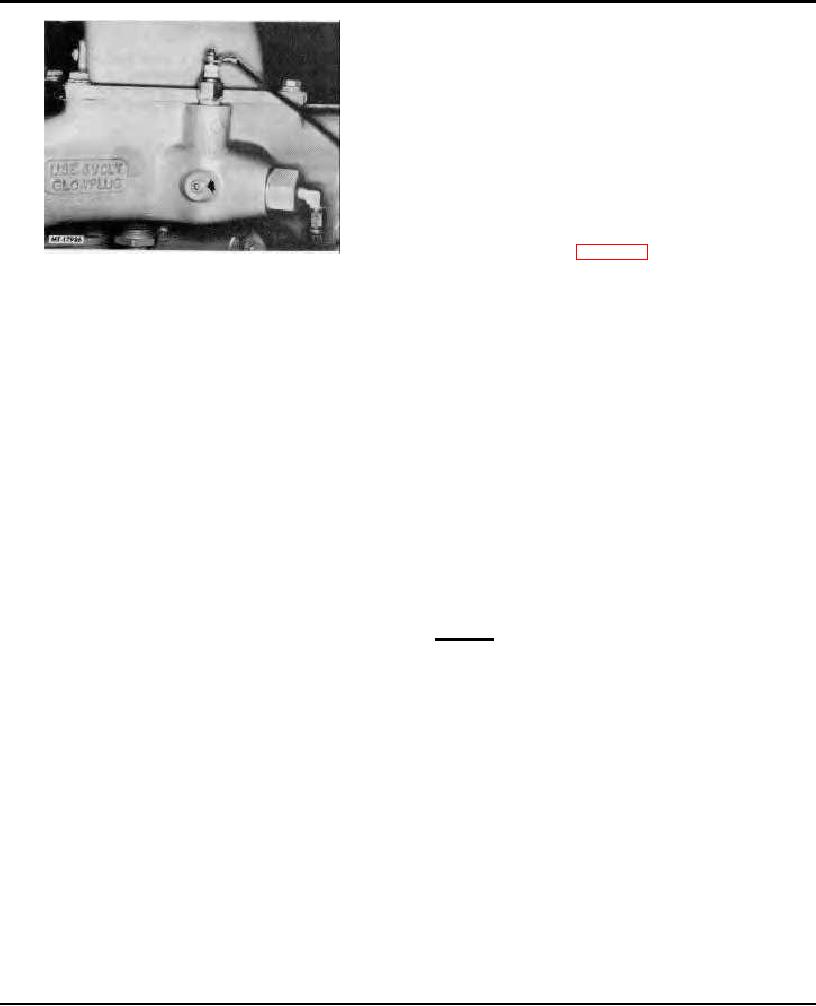
OPERATION
GOVERNED SPEEDS
All Cummins engines are equipped with governors
to prevent speeds in excess of maximum or
predetermined lower speed rating, except when pushed
by load downhill, etc.
The governor has two functions: First, it provides
the exact amount of fuel needed for idling when the
throttle is in idling position. Second, it overrides the
throttle and shuts off fuel if engine rpm exceeds the
maximum rated speed.
Speeds listed in Table 1-2 are for engines rated at
maximum rpm and fuel rate; many engines are set at
FAILURE TO START
other values due to equipment being powered or loads
applied to equipment and engine.
1. If the engine gives no indication of starting
during the first three full strokes of the preheater pump,
USE THE TACHOMETER
touch-check the intake manifold for heat. If there is no
heat, check electric wiring. If wiring is all right, remove
Rated engine speed is the rpm attained at full load.
1/8 inch pipe plug (1, Fig. 1-5) from manifold near glow
Governed engine speed is the highest rpm a properly
plug and carefully check for flame while a helper
adjusted governor will allow the engine to turn, no load.
performs the preceding Steps 2, 3 and 4.
Governed engine speed must never be exceeded on
2. If no flame is observed, close glow plug manual
downgrades or any other condition in which the load
switch for 15 seconds and observe glow plug through
drives the engine.
1/8 inch pipe plug hole. The glow plug should be white
hot; if not, connect wiring to a 6 or 12-volt (as used)
OIL TEMPERATURE GAUGE
source and check amperage; it should be 30 to 32
(minimum). If glow plug is all right, check manual switch
The oil temperature gauge normally should read
and resistor (if used) and replace if necessary.
between 180 deg. F (82 deg. C) and 225 deg. F (115
deg. C) for best lubrication. Under full load conditions, a
ENGINE WARM-UP
temperature of 250 deg. F (121 deg. C) for a short
period is not to be considered cause for alarm.
When the engine is started, it takes a while to get
the lubricating oil fim re-established between shafts and
Caution: Any sudden increase in oil temperature
which is not caused by load increase is a warning of
possible mechanical failure and should be
favorable clearances between moving parts are obtained
only after all engine parts reach normal operating
investigated at once.
temperature. Avoid seizing pistons in liners and running
During warm-up period, apply load gradually until oil
dry shafts in dry bearings by bringing the engine up to
temperature reaches 140 deg. F (60 deg. C). While oil
operating speed gradually as it warms up.
is cold it does not do a good job of lubricating.
Continuous operation with oil temperatures much below
On some emergency equipment (such as fire
140 deg.
F (60 deg.
C) increases likelihood of
engines) warm-up may not be necessary due to
crankcase dilution and acids in the lubricating oil which
equipment being housed inside a heated building.
quickly accelerate engine wear.
ENGINE SPEEDS
WATER TEMPERATURE GAUGE
IDLE SPEEDS
A water temperature of 165 to 195 deg. F (74 to 91
deg. C) is the best assurance that cylinder liners are
In most applications engine idle speeds are 580 to
heated to the proper temperature to support good
650 rpm; however, the parasitic load may require a
combustion and that working parts of the engine have
slightly higher value to smooth cut operation.
expanded
35

